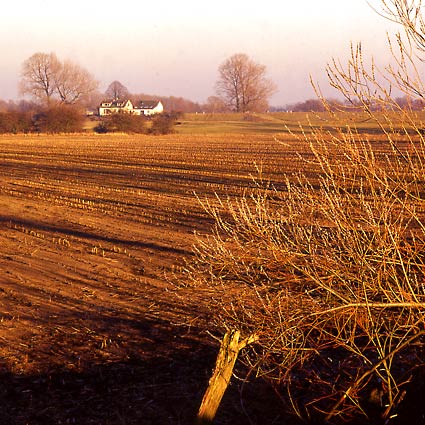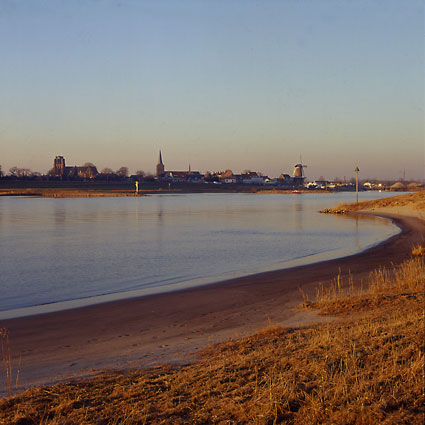
Most photographers are fond of camera tests, endless debates about brands, specs etc. Apart from admiration (or
idolatry if you want) of the technical potential of gear, photographers often think that better equipment makes one a better photographer.
Of course that's nonsense. The photographers makes the image, not the camera. Equipment is the
craftsman's or craftswoman's tool. It is loved as such, but it can never be an aim on its own.
But why an article about the Rollei 6008 here on this site? Do I believe gear makes the photo?
No! But without good, reliable and appropriate tools one cannot expect to deliver consistently good work. So the choice of a camera system and the parts you want to have is important! And I hope this article can be of help for those who think about their equipment.
Important: I write about my own experience here and about things that are of importance for me and the kind of work I do. There is not such a thing as a general best buy: it all depends on your own preferences and the kind of use. If you want to paint the house, you'll use another kind of brush than when you make wooden toys.
For years I have used a Bronica EC system for medium format. I wrote about my experience with this camera in the article Scotland, camping with a Bronica 6x6
For my landscape work and (wedding) reportage this is a fine system. The ergonomics and users interface is clean, one can work fast and the optical quality of the Zenzanons is more than enough for me. Because of its age (the seventies) a complete camera system can be had for relatively little money.
In short: the EC is a good camera and offers more than enough for the use I have for it. The problem though is in the ones I have: because of years of professional use they suffer from a lot of tear and wear. The can be refurbished again and again, but feels kind of bad to bring three cameras to a job and have them all out of order. Not so much of a problem for landscape - after some fiddling and playing they often go back to work - but very bad for events.
So I had to choose: looking for another, reliable EC or EC-TL? A different, new 6x6 system? A different format may be?
Choice #1 was no option, as I want to work for years and years to come with my medium format gear. Better now change systems than have the same problem within a few years.
Because of my love for the square - in the album and projected - 6x4.5 and 6x7 are no option either. Ergo: a modern 6x6 system.
In 6x6 there are three options to choose from: Bronica SQ (not compatible with EC!), Hasselblad or Rollei.
Because of the specs Rollei is to be preferred: the light can be metered with the waist level finder (not with a special prism only). The standard winder is a nice feature.
Because of price Bronica is to be preferred, but as soon as you buy a winder and metering prism this is no advantage anymore.
The best lenses are built for Hasselblad and there is a huge second hand market. But prices are very high. The cameras lack the automatic features of the Rollei. And for a large part Rollei uses the same optics.
Something one can't read in catalogues and price lists is the reliability of a certain camera system. The dealers and photographers I talked with about my wishes, told me all three brands are in the same league here. And repair is a costly affair everywhere. Service is on the same level. Rental options of medium format gear are minimal anyway in the Netherlands.

Decisive was a visit to Hans van Dorssen, chairman of Rolleiclub Nederland. I could play around with his Rollei and lenses for more than an hour. He also told me that eventual repairs were done in Germany and done and returned within three weeks. A plausible term.
Next question is: new or secondhand? Because of my experience with unreliability of my ECs I longed for the new stuff, especially with respect of the camera - no doubts about wear and tear and former (ab)use. On the other hand: my budget isn't unlimited.
In the end I bought first a second hand 6006 (model 2) and a Rollei distagon 50 4.0 PQ. I wanted a 50mm anyway and this kit was cheaper than a new 50mm EL.
Then I bought a new 6008i and a Rollei sonnar 150 4.0 PQ, an extra accu and an extra back.
A dealer and friend of mine sold me a demo Schneider xenar 80 2.8 PQ and a second hand 6006 prism and a number of inserts.
In short: a very nice set with a back-up camera. The only things I have for the Bronica and not for Rollei are: extension tubes and a 250mm and a 2x convertor. Because I make some close-ups for the wedding album, a 17mm tube is high on the list. The longer telelenses are used for landscape work and can be waited for.
Actually there are three kinds of differences, I experienced during the transition from Bronica EC to Rollei 6008: relevant advantages, relevant disadvantages and irrelevant differences.
Last thing first: after having worked with a certain tool for years one always has to get used to a new one. For
example: the Rollei focuses clock-wise to infinity (standing behind the camera), the Bronica anti-clock-wise.
Because, different than the Bronica, the film winds from top to bottom, the numbers on the negs are on the left side of the frame in stead of on the right side.
Relevant disadvantages: not so many. Price is high, but very reasonable. The lenses are heavier, but the camera weighs less. But the Rollei stuff is rather big and voluminous, so my bag is a bit too small.
The minimal focusing distance of the 50mm and 80mm is longer than those of the Bronica's (50 in stead of 35 cm and 90 in stead of 60 cm). That is a pity.

Relevant advantages: quite a lot. The built in winder is more welcome than I first thought. It gives me more time to stay in touch with people I make photographs of. The lightmeter is precise and is well usable. Because of my own workflow I use it along my trusty Pentax MZ5n, like I was used to with my Bronica. Maybe I will rely on the Rollei only in the future - time will learn.
Very nice are the distance scales on the lenses - something the Bronica lacks due to its universal focusing unit, used by almost all lenses. Therefore I can work more easily with hyperfocal distance or put the lens on a certain distance. The minimal focusing distance of the 150mm is at 150 cm better than the 2 metres of the Zenzanon. That is nice.
The screen is far brighter than the EC screen and in the same league as the Maxwell screen I had made for my Bronica. The Rollei also shows a larger part of the final image; so much more that I can see more in the finder than the lab will print. With slides the area is almost exactly the same as the Gepe mounts I use.
The handgrip of the Rollei enables easy working without tripod - I have to be careful not to work without tripod, even if that delivers better sharpness (for fast working I use my 35mm anyway).
The separate inserts can easily be loaded at home and used very quickly - very nice while doing group shots or during rainy weather. This is also possible with the EC backs, but the separate inserts weigh a lot less and take a little less space.
Finally: the prism can be turned, which is nice if I want to put the camera as much to the wall as possible. I can turn the Bronica prism 90 degrees if I want, but it cannot be locked - unless the Rollei, which won't fall on the ground.
So is the Rollei the end of all dreams? Well, nothing is perfect. To my liking the analogous expose scale should be extended up to three stops either way (now it only goes to one stop up and down; not enough to spotmeter for shadows and highlights). I cannot think for more now (apart from autofocus, but of course there is a 6008 AF now).
Should I have made my choice on an earlier date? No; if my ECs still would work without any mechanical problem I still would work with them with lots of pleasure. Nevertheless I appreciate all extra features and possibilities.
May be you already noticed I didn't say a thing about the optics. Are those German lenses better than their Japanese counterparts?
As far as I can conclude from the first tests and the results of my first wedding with this camera, I want to say this: those German lenses are terrific. But so are my Zenzanons - though the (newer) Rollei lenses are probably a few per cent sharper. The Rollei images are a bit more three dimensional, but the transition from sharp areas to back- and
foreground of the Zenzanons is nice as well.
Another question: why no digital? For me it comes down to this: I really like the projection of my landscape work. Digital can't compete with film here.
Because I don't get film through my camera full time, digital is certainly not cheaper for me - unless the price of high-end digital will drop a lot further.
Finally the learning curve of digital and the processing of the images cost lots and lots of time. I even doubt if for me digital ever will be more cost effective than film. For now I like the analogue workflow, and for special effects I can always have my films
digitalized at my lab.
The last months I have had some more experience with the Rollei. I also bought 9mm and 17mm extension tubes, which are of great use for some wedding details, like flowers, and for nature work.
A sunny Februari day also saw the first serious use of the Rollei for landscape work. I share some of this experience here.
Compared to the extension tubes for the Bronica EC, the Rollei ones seem very expensive: about 10 fold (both second hand). But what a difference in use! The EC tubes are simple mechanical tubes, with screw thread on both ends and a more sophisticated one to couple to the lens and to close the aperture.
The Rollei ones are fully electronic. Open lens ttl metering is no problem, they fit very precisely and can be connected and disconnected in every order.
For image quality there is no difference, but the Rollei tubes give a far better workflow. Lovely.

 Another very useful Rollei item is the electronic cable release, with buttons for 'mirror' and 'start'. No longer the stiff cable and the on camera mirror lock-up button I had to use for the Bronica. Often I lock up the mirror of the EC and then use the normal release button on the front of the body, without the cable. In the same time I pushed the camera down with my other hand. Worked for me, but the electronic cable is much more easy to use.
Another very useful Rollei item is the electronic cable release, with buttons for 'mirror' and 'start'. No longer the stiff cable and the on camera mirror lock-up button I had to use for the Bronica. Often I lock up the mirror of the EC and then use the normal release button on the front of the body, without the cable. In the same time I pushed the camera down with my other hand. Worked for me, but the electronic cable is much more easy to use.
Something I didn't need during the weddings, is another difference: the Rollei 50 and 150 can be closed down to f32 (vs. Zenzanon 22), which can be useful in certain circumstances. I'll have to check if the overall image quality is still within what I think is acceptable, but the first results are promising. DoF problems can be more obvious than a bit less resolution.

The Rollei's shutter speed can be manually set with clicks at every 1/3 stop - and the same applies to the lenses. I find this very useful when shooting slides - more convenient than the EC, where you can only set the aperture in between stops and even then without clicks.

And last but not least: the optical difference between the Zenzanons and their Zeiss & Schneider counterparts are more pronounced than I thought at first. The latter deliver sharper looking prints, with a pleasant contrast (of course, same lab same film). The Zenzanons are certainly nice as well, but I never had to think about eventually using a soft filter, but now I do!
In other words: the difference in optical quality certainly is a plus for landscape, group shots and the like, but can be a bit too much for some portraits. But one can degrade very high definition with a filter, not upgrade less high definition - so overall I am very pleased!

Please bear in mind that pictures on the web never can tell something real about optical quality. They are here just to show what kind of work I am doing with the Rollei.
More about my experiences with the 6008 as a camera for landscape photography:
keeping the books, reviewing the results of a two week landscape shootChristmas 2003 I took the Rollei with me to Scotland. I even fell more in love with the country - and the camera! It was also my first trip I used the 250mm (non-PQ) and Velvia 100F.
Read about it here: 'Every morning is different'From October 2006 on I work with the Rollei digitally. In a back to the future, new ways in my landscape photography I muse about digital landscape photography and describe my first experiences in the field.